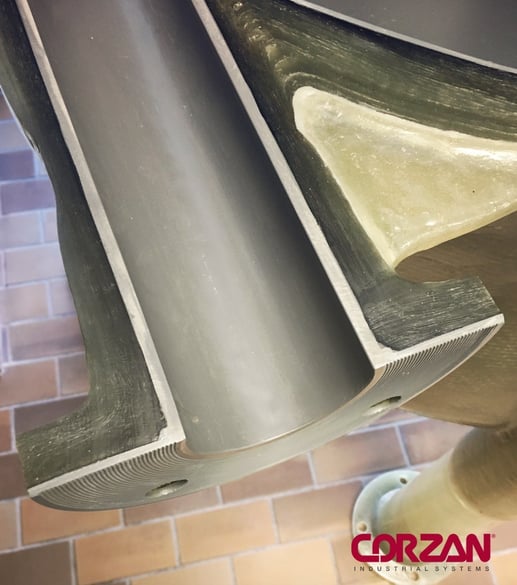How to Extend Pipe System Life in High Temp, Corrosive Applications
Stand alone Corzan® CPVC piping is inherently tough. Its high heat distortion temperature, impact resistance, and pressure rating can stand up to the demands of many industrial applications.
That said, there are chemical processes that require corrosion resistance, but have a fluid temperature exceeding Corzan piping’s working range.
For these situations, dual laminates are becoming more commonly specified. Dual laminates combine the superior chemical resistance of Corzan CPVC with the mechanical strength of fiber reinforced plastics (FRP). This translates to longer service life, lower maintenance costs, and improved reliability.
How Dual Laminate Pipes Work
In dual laminate piping, a thermoplastic is used as the liner, serving as the pipe’s interface with a liquid or medium. When Corzan CPVC is specified, the material’s inherent resistance to many of the aggressive, highly corrosive fluids used in chemical processing systems makes it ideal for these demanding applications.
The Corzan CPVC liner is then reinforced on the outside with a fiberglass reinforce plastic (FRP) shell. The fiberglass is applied with a bonding resin, and when cured, forms a solid exterior. This creates a pipe that is both relatively lightweight and structurally strong.
Pictured below is the flange of a CPVC dual laminate tank from Fabricated Plastics. Notice that the inner liner is a corrosion resistant layer of Corzan CPVC secured by a FRP shell.

There are a variety of bonding resins and fiberglass materials available for dual laminates, providing flexibility when it comes to the qualities of the piping exterior. This enables manufacturers to customize the piping to satisfy the high temperature demands placed on the composite system and keep the liner structurally sound.
Mechanical Properties of the Dual Laminate Pipe
In a dual laminate piping system, the FRP exterior provides 100 percent of the structural strength. This means specific mechanical properties of a Corzan CPVC pipe become less of a concern.
What’s Enhanced with a Dual Laminate?
The most significant impact of the fiber reinforcement is on Corzan CPVC’s working temperature range.
Depending on the system pressure, standalone Corzan piping is rated up to 200°F (93.3°C).
In a dual laminate system, however, warping caused by high heat exposure becomes less of a concern. In fact, many applications are using Corzan CPVC in dual laminates at temperatures 20 to 25°F (11.1 to 13.9°C) higher than what it can handle normally.
Pressure bearing capabilities can also improve. The dual laminate determines how much pressure the pipe can withstand, and the fiberglass and resin materials can be engineered to satisfy these requirements.
What Stays the Same?
With the FRP taking care of the structural aspects, Corzan CPVC’s other capabilities can be applied to more extreme environments:
- Chemical Resistance: In standalone FRP piping, corrosion barriers are selected for specific chemicals and don't perform well outside of the specified requirements. Unfortunately, most processing streams are not pure, and contain chemicals that can cause havoc on FRP. With dual laminates, Corzan CPVC provides a layer that is inherently inert to many acids, bases, salts and aliphatic hydrocarbons. This allows the piping to be used when multiple contaminates from different chemical families are present. View the Corzan Chemical Resistance Chart for CPVC's compatibility with 400+ chemicals.
- Smooth Surface: Because CPVC is resistant to scaling and fouling, the pipe’s inner surface remains smooth for the life of the material. This means that friction pressure losses in the fluid flow are minimized from the beginning and do not significantly increase as the system ages.
- Good Thermal Insulation: Corzan CPVC’s thermal conductivity value is approximately 1/300th that of steel. This enables you to avoid costly insulation where piping may be exposed.
- High Impact Strength: Corzan CPVC can withstand three times the impact strength of standard CPVC. This means the pipe is easier to cut, resulting in fewer fractures, breaks and ultimately, a lower scrap rate.
Dual laminates are also great for tanks, vessels, ducts, scrubbers and other structures where chemical resistance and structural strength are required. Because of Corzan CPVC’s thermoforming qualities, the vinyl can be molded into any shape, allowing for precise, custom configurations.
Choosing a Fabricator
It is worth noting — Your choice of fabricator becomes very important when specifying a dual laminate piping system or structure. The liner is the most important part of a dual laminate system, and any failures in it will directly impact the service life and cost of the system. The best fabricators offer the skill, material expertise and equipment to ensure seams and welds maintain the smooth interior surface and uphold the integrity of the system.
Have Questions?
If you have questions or would like the advice of one of our product and engineering specialists, we’re happy to schedule a consultation.


